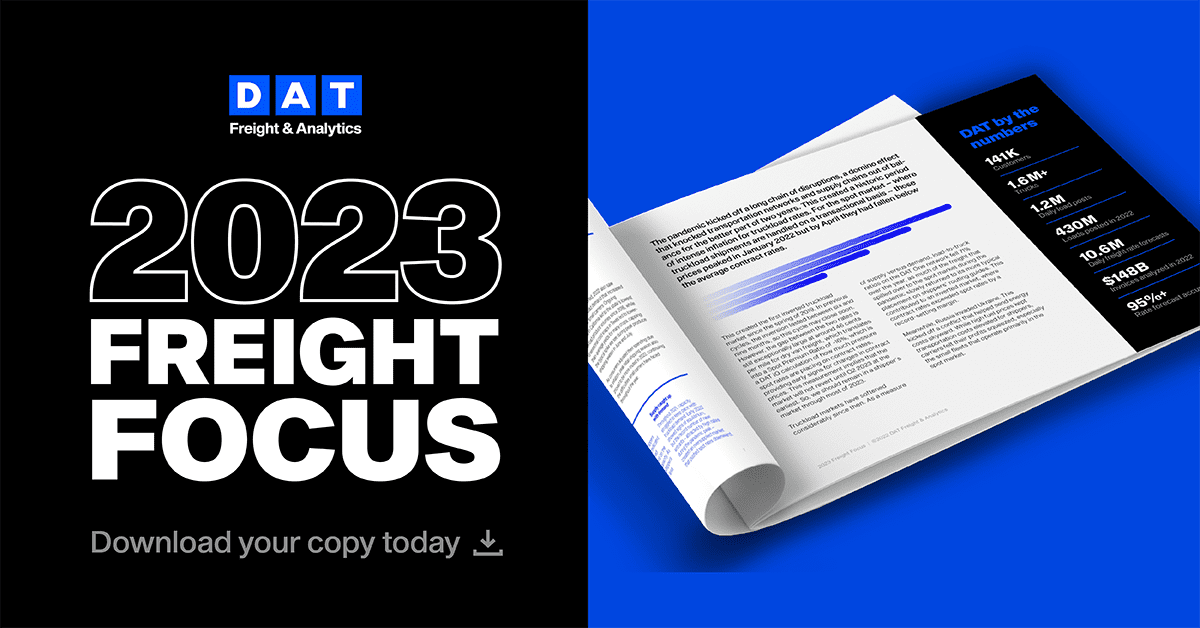What a difference a year makes. Twelve months ago, we were talking about constrained truckload capacity and surging demand, as disruptions and bottlenecks piled up to wreak havoc on supply chains. A year later, transportation providers and purchasers have a different cloud of uncertainty hanging over them – the economy.
Is a recession coming (or is it already here)? If so, how deep will it be? The answer to these questions will shape much of 2023. But to understand where we’re going, it helps to look at how we got here.
The pandemic kicked off a long chain of disruptions, a domino effect that knocked transportation networks and supply chains out of balance for the better part of two years. This created a historic period of intense inflation for truckload rates. For the spot market – where truckload shipments are handled on a transactional basis – those prices peaked in January 2022 but by April they had fallen below the average contract rates.
This created the first inverted truckload market since the spring of 2019. In previous cycles, the inversion lasted between six and nine months, so this cycle may close soon. However, the gap between the two rates is still exceptionally large at around 46 cents per mile for dry van freight, which translates into a Spot Premium Ratio of -16%, which is a DAT iQ calculation of how much pressure spot rates are placing on contract rates, providing early signs for changes in contract prices.
This measurement implies that the market will not revert until Q2 2023 at the earliest. So, we should remain in a shipper’s market through most of 2023. Truckload markets have softened considerably since then. As a measure of supply versus demand, load-to-truck ratios on the DAT One network fell 71% over the year, as much of the freight that spilled over to the spot market during the pandemic slowly returned to its more typical placement on shippers’ routing guides. This contributed to an inverted market, where contract rates exceeded spot rates by a record-setting margin.
Meanwhile, Russia invaded Ukraine. This kicked off a conflict that helped send energy costs skyward. While high fuel prices kept transportation costs elevated for shippers, carriers felt their profits squeezed, especially the small fleets that operate primarily in the spot market.
Many of the bottlenecks of 2021 eased in 2022. For example, the number of ships waiting to unload off the coast of Los Angeles fell to the single digits by the end of the year, down from over 100 in January. The markets reshuffle Much of that freight found its way to East Coast and Gulf Coast ports. In October, port volumes increased by 10% and 28% respectively, compared to 2021, as importers sought to avoid port congestion and labor disputes on West Coast ports. That shift sent West Coast import volumes down 11% year over year as a result. The coastal shift in import volumes put less stress on California transportation networks but created a surge in truckload volumes for containerized and break-bulk freight in Houston; New Orleans; Mobile, AL, and Savannah, GA.
Regardless of the location, the surge in containerized imports over the past two years put stress on many parts of the supply chain. Empty containers backed up at ports, dray carriers couldn’t collect loaded containers, chassis trailers were in short supply, and overcrowded warehouses kept receivers from unloading containers. As imports tailed off toward year’s end, container and chassis trailer congestion improved.
Meanwhile, warehouse space showed signs of easing during the retail holiday shopping season. While markets reshuffled, 2022 also saw declines in truckload demand that increased difficulties for small carriers.
See our experts talk about these trends here.
Ongoing droughts in California led to the state’s lowest truckload produce volumes since 2016, while unseasonal cold snaps in Texas led to lower-than-average yields for many crops, capping the typical spike we see during peak produce shipping season in June and July. As consumers adjusted their spending due to inflation, peak retail shipping season also proved to be more muted in 2022, continuing the difficulties small carriers have faced throughout the year.
—————————————————————————————————————————–
The above is an excerpt from the Freight Focus, DAT’s annual year-in-review report. Get the full report and all our expert analysis of 2023 here.



